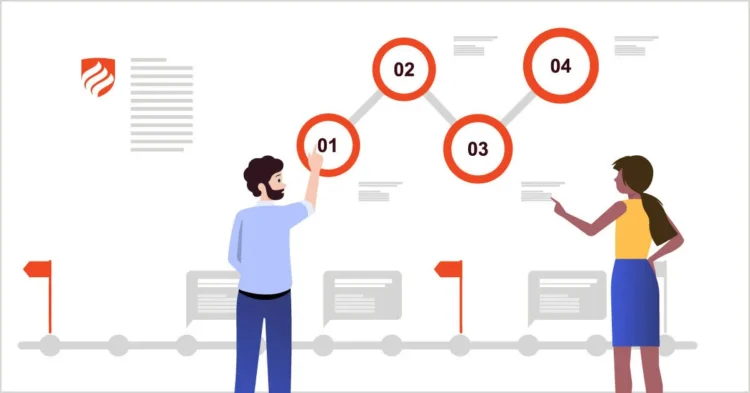Ensuring that a project is finished on time and within range is essential in project management. The Critical Path Method [CPM] is one of the best methods for controlling schedules and guaranteeing timely project completion. To work effectively on projects, it is recommended that you undergo a Microsoft Project Course. When integrated with Microsoft Project, the CPM transforms into a practical tool with many advantages.
This blog examines the benefits of applying Microsoft Project Critical Path Method and shows how it may significantly increase project management effectiveness.
Page Contents
Table of Contents
- Understanding the Critical Path Method
- Benefits of Using CPM in Microsoft Project
- Conclusion
Understanding the Critical Path Method

Source: hygger.io
Before discussing the advantages it’s critical to understand the Critical Path Method (CPM). This project management method establishes the order of essential phases or assignments that immediately impact the project’s completion date. By identifying these crucial tasks, project managers can guarantee that delays are prevented and the project stays on track.
Benefits of Using CPM in Microsoft Project
Enhanced Project Scheduling
Microsoft Project offers a robust foundation for building intricate project schedules with CPM. By determining the critical path project managers can determine which tasks are necessary for the project’s timely completion. This visibility guarantees that essential tasks are prioritised and aids in more efficient planning and resource allocation.
For instance, the essential route of a construction project can include jobs like framing, roofing, and constructing the foundation. With this knowledge, the project manager can ensure these tasks are finished on schedule and in order, preventing delays in the project’s overall timeline.
Improved Resource Management
One of the main advantages of implementing CPM in Microsoft Project is the enhanced resource management. By identifying important tasks, project managers can direct resources where they are most required. This guarantees that important tasks have the employees, tools, and supplies needed to be finished on time.
Project managers can eliminate bottlenecks and ensure a smooth workflow by allocating resources correctly, for example, if a critical activity calls for specialised equipment or knowledge. This targeted resource distribution lowers the possibility of resource-related delays while simultaneously increasing efficiency.
Better Risk Management
It is an essential component of project management. Project managers can use CPM in Microsoft Projects to determine possible risks and their effect on the project timeline. By keeping an eye on the critical path managers can identify potential delays and create backup plans to reduce these risks.
For example, the project manager can proactively look for alternate suppliers or modify the schedule to account for possible delays if crucial work is in danger of being delayed because of supplier problems. Thanks to this proactive approach to risk management the project will remain on course even in the face of unforeseen obstacles.
Increased Accountability and Communication
The critical path’s clarity improves the project team’s accountability and communication. Team members are more likely to remain concentrated and dedicated to achieving these goals when they know which tasks are crucial and when they are due.
Project managers can share the critical route and project plan with the team using Microsoft Project, which makes this easier. Regular updates and progress reports guarantee that everyone is informed of their roles and the state of the project. This transparency improves team members’ accountability, cooperation, and communication.
Effective Time Management

Source: elmhurst.edu
Effective time management is essential to any project’s success. Project managers can determine the shortest path to completion by using CPM in Microsoft Projects. By concentrating on the most critical tasks managers can ensure that no time is lost on non-essential activities that have no bearing on the project’s final deadline.
Emphasising important tasks enables more efficient time use. Project managers can establish reasonable deadlines, track developments, and make necessary revisions to guarantee that the project is finished on schedule.
Streamlined Workflow
When CPM is used in Microsoft Projects, workflow is streamlined. Project managers can reduce delays caused by tasks waiting for necessary activities to be performed by identifying dependencies between tasks and ensuring that tasks are executed in the correct order.
For instance, before testing can start in a software development project, some tasks like coding must be finished. The project manager can avoid delays in the project timetable by using CPM to ensure that code is completed on time and enabling testing to begin on time.
Data Driven Decision Making
Microsoft Project offers comprehensive analytics and statistics based on the critical route. Using this information, project managers may decide how best to allocate resources, rank tasks, and modify the timeline. Thanks to this data-driven approach, decisions are made based on actual project performance and schedules, not conjecture.
For example, the project manager can use data analysis to determine the reason behind a vital task’s persistent delays and implement corrective measures. This could entail redistributing resources, modifying the timetable, or addressing problems contributing to the delays.
Cost Management
Using CPM in Microsoft Projects also offers the benefit of efficient cost management. Project managers can optimise budget allocation and prevent unnecessary expenditures by prioritising essential tasks. This guarantees that the project meets all its deadlines and stays within budget.
Project managers, for instance, can save money by allocating resources at the last minute and avoiding overtime costs by prioritising key activities. This proactive approach to cost management maintains the project budget and maximises the return on investment.
Conclusion

Source: medium.com
When combined with Microsoft Project, the Critical Path Method has several advantages that can significantly improve project management effectiveness. Through enhanced scheduling, resource management, risk mitigation, and accountability, CPM provides project managers with the necessary instruments to guarantee the triumphant culmination of their projects. Project managers may complete projects to the highest levels of quality, on schedule, and within budget by utilising Microsoft Project’s features and keeping an eye on the critical path. Learning Microsoft Project’s CPM is a valuable endeavour that can result in more efficient and successful project outcomes.
Learning Microsoft Project’s CPM through resources like The Knowledge Academy is a valuable endeavour that can result in more efficient and successful project outcomes.




